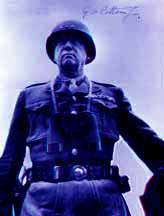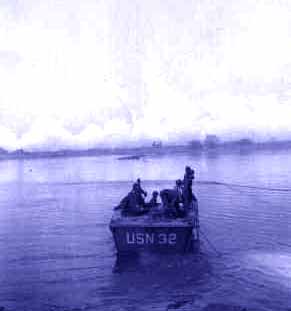Goss and the other officer were assigned fifteen LCMs and were ordered to have them painted olive drab before transporting them and 75 sailors to France. Their secret mission had them joining the Third Army, commanded by “Old Blood and Guts” himself, General George S. Patton. Their job was to use the boats to transport Patton’s army across the Rhine River as part of the final Allied assault into Germany.
This was the first time the Navy had been used in such an operation and, since it was secret, Goss could only refer to it in an off-hand manner in his letters home. He refers to the possibility that the German counter-offensive called the "Battle of the Bulge" might endanger the Rhine operation.
In addition to the frigid temperatures, the officers had to deal with the boredom of the sailors who had too much time on their hands as they waited for the Rhine operation to begin. Goss found some scrap metal and fashioned a basketball hoop that he attached to the wall of one of the buildings. He organized a league in which the troops would compete in one-on-one half-court basketball. This helped to use up some of the pent-up energy which otherwise would have been expended on fistfights and other mischief. The officers also managed to acquire large quantities of wine and liquor and threw a huge party that lasted for a day and a half.I haven't any idea when I will get home--I can't tell you about what I'm doing now or rather what I will do--but it is something that the Navy has never done before--of course, there's a good possibility that we won't be used--especially since the Germans made that big break through and that ole man winter has set in and sorta froze us up. It has been snowing all day and everything is covered with a white blanket--very beautiful to see--guess we will just sit around and wait. 5
Finally, in late March 1945, the weather had sufficiently moderated to enable the American forces to move up to the Rhine River in preparation for the crossing near the German town of Mainz. The river is more than one thousand feet wide at this point. This was the first time in the history of the U.S. Navy that its personnel and equipment were used in an operation far from the nearest ocean. The naval crossing was to be a precursor to the pontoon bridge-construction efforts of the Army engineers. The First Army had seized the famous Remagen Bridge in early March but German resistance was so fierce that the bridge was unusable.
After practicing their crossing techniques on the Moselle River in northeastern France, twelve boats were successfully transported on tanker trailers to the banks of the Rhine. It was an amazing sight for the German civilians to see these large boats moving down their roads and through their towns and villages. Several times as the Americans tried to maneuver the boats through narrow city streets, they had to knock down buildings to make room for them.
Never was there a stranger sight than our caravan of boats slogging around over German roads. We had 36 and 50-foot craft lashed to huge tank retrievers. Several times we had to stop and blast buildings and houses out of the way to get the boats through. 6

Gen. George S. Patton
General Patton was especially anxious to get his forces across the river because he knew that his despised rival, British Field Marshall Bernard Montgomery, was planning his crossing further downstream. So on the evening of March 22, Goss and his men prepared for the crossing that would take place shortly after midnight. Because of the loss of the crane that was to unload the boats, bulldozers pushed the landing craft off the transporters and into the water without any significant damage to their hulls.
In order to soften enemy defenses, American artillery had been used extensively against the Germans located on the eastern shore of the river but the night crossing surprised them and contributed greatly to the success of the operation. As reported by two on-the-scene eyewitnesses, a great deal was accomplished on the first day alone.
On the first day...at the point where the two chief photographers were taking pictures, the Navy craft landed across the Rhine 300 tanks and tank destroyers with crews, 1,000 jeeps and trailers, and 4,000 troops. They brought back across the river 200 American wounded, [and] 2,000 German prisoners of war. 7
A Dallas newspaper account quoted Lt. General Omar Bradley:
Allied armies can cross the river ‘most anywhere at any time’ and a Berlin broadcast said that Field Marshall Montgomery in the north ‘seems to be ready’ to do just that’...American losses in driving up to the west bank were extremely small compared to the catastrophic losses of the foe, Bradley said.8
None of the boats were lost and during the next several weeks four more crossings were made. For Stormy Goss, however, the success of the operation would be forever stained by heartbreak. He and his best friend were dug in on the western shore of the Rhine when their unit was

The Rhine Crossing
targeted by German “treetop explosives” fired from across the river. These were artillery shells that were timed to explode 15-20 feet above the ground so that hunks of jagged metal would shatter everything below. Goss’s friend, Vincent Avalone, was an Italian-American from the Bronx who on that very day had been talking about the anniversary of his father’s death exactly eight years earlier. "Avie" was sure that if the two of them stayed together, they would survive the war. When they heard the all too familiar and terrifying whine of the approaching shells, they jumped in adjoining foxholes. Goss was covered with dirt kicked up by the explosion. When he dug himself out, he checked Avalone’s foxhole and started digging only to discover his friend’s inert body.
My prayers have been that this horrible mess will soon cease.
Avie had apparently been killed instantly by the exploding shell. Goss was devastated. He and Avalone had been through so much hardship together and now, as the war seemed to be finally winding down, it seemed incomprehensible that such a tragedy could occur. As soon as he found the time, he took his friend’s dog tags and some personal effects to Paris so that they could be sent to Avalone’s mother in New York. Vincent was her only child.
I can’t remember ever being as sad and broken-hearted as I am tonight—I’m sure I have mentioned in my letters and sent pictures home of my friend “Avie”...we have been together almost day and night since last September...He was an Italian fellow, a Catholic, and one of the best fellows I have ever known. I loved him almost like a brother...He was killed yesterday morning about 7:00am only a few feet from me ...I couldn’t believe it Mom—it still doesn’t seem true that he is dead... A few days after you receive this, will you write Mrs. Avalone a letter...You know what to say Mom—I don’t... I can’t tell you much about the river crossing yet—It was living hell. [Illegible] to your prayers Mom, the good Lord brought me through—I didn’t receive a single scratch—I’m still shaky and jumpy but otherwise I’m okay. 9
Goss and his contingent of sailors stayed near the Rhine for several weeks following the crossing. In early April he wrote his fiancée about the shelling at Mainz:
Kay, you have no idea how close your future husband came to having his name on the casualty list— I don’t know how I escaped except that the good Lord was watching over me—It was damn near too much for me. I’m still jumpy but things are very quiet here now so I’m not bothered much. 10
Later, he reflected on his combat experiences and compared them with a close friend who was in the Army.
Kay, don’t think that I did anything unusual just because I was in on the Rhine crossings and had a few narrow escapes because it really wasn’t anything—Guys like Willie who are in the infantry and other fellows go through that many times and many times worse than what we ran into—Truthfully, I’m certainly glad that I’m in the Navy and not in the Army—The army life is a rugged, tough life and they really go through hell. 11
At one point, Goss encountered General Patton who ordered him to gather the sailors together because he wanted to talk to them. In his typically profane manner, the general complimented the Navy men on the job they had done during the river crossings and shook the hand of each man.
General Patton called the sailors together and in his rough way really commended them for their work. It was a classic commendation, all right—profanity and praise mixed pretty beautifully. 12
In May Goss was ordered back to England as the European war seemed to be sputtering to an end but the prospect of continued fighting in the Pacific dampened hopes that he and others would soon return to civilian life.
My prayers have been that this horrible mess will soon cease—but for some reason I can’t seem to get excited about it now—Guess because we all have been expecting it for the past month so we just figure it’s all over now. If the Japs would only see the light now and toss in the towel, everything would be wonderful— most of the fellows could go home and start their lives over again—But apparently Hirahito doesn’t think the same as the Nazis and so you will probably be a Navy wife for a couple or three more years. 13
On May 7, 1945 the Germans surrendered and "Victory in Europe" was celebrated world-wide. Goss was in London as the city erupted in a prolonged and joyous celebration.
V-E Day wasn’t very exciting to me because I had been expecting it for so long—it came as an anti-climax. Of course I was happy and thanked God that it was over—I spent V-E Day in London and they were certainly a happy people—New York may have been gayer and drunker but I bet London was happier—Lights were turned on and everyone was singing and dancing—I went to Buckingham Palace and saw the King and Queen, took lots of pictures and acted as a spectator 14
